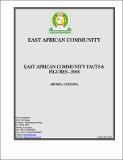| dc.description.abstract | The EAC Facts and Figures Report presents empirical data of socio-economic indicators in the region from which trends of development and growth levels can be analyzed. Regional issues such as negotiations on the Common Market and Monetary Union and their subsequent implementation will rely on availability of reliable statistical data.
Findings indicate that EAC midyear population was estimated at 122.1 million by June 2007 with average annual growth rate of 3 percent. The annual Infant mortality rate and child mortality rates ranges between 62 to 86 and 103 to 137 respectively in 2007 while literacy rate of the region is estimated between 62 and 74 percent in 2007.
Overall, the EAC recorded an average real growth of 6.8 percent in 2007 and average per capita of US$ 424 with Kenya US$ 725.5, Uganda US$473, Tanzania US$440, Rwanda US$365 and Burundi US$119. In aggregate, total GDP for the region amounted to US$ 60,491 million in 2007, compared to US$ 52,328 in 2006. The average annual underlying inflation rate increased to 7.6 percent in 2007 from 5.4 percent in 2006. The highest increase was on food prices. On average, the EAC fiscal deficit, excluding grants, as a ratio of GDP worsened from 9.4 percent in 2006 to 11.1 percent in 2007.
Further analysis reveal that in the year 2007, tourism grew at an average rate of 12.5 percent lower than 13.0 percent in 2006. On average, coffee production in the region has been on the decline since 2003 while tea production has been on the increase. The period 2003 – 2007 has witnessed a decline in hydro power generation as a proportion of total generation. However, the region has had a gradual increase in thermo power generation.
The data in the report was obtained from the National Statistics Offices, Central Banks of the Partner States and other government departments and targets a wide spectrum of users including policy makers, researchers, investors, academicians and development Partners. | en_US |

